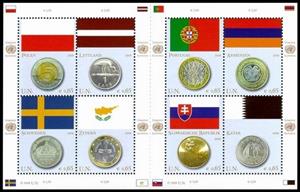Booklet Pane: Flags and Coins (UNO Vienna 2008)
Flags and Coins (UNO Vienna 2008)
08 May (UNO Vienna ) within release Flags and Coins goes into circulation Booklet Pane Flags and Coins face value 8*0.65 Euro
| Booklet Pane Flags and Coins in catalogues | |
|---|---|
| Michel: | Mi:NT-WN 530-537 |
| Yvert et Tellier: | Yt:NT-WN 545-552 |
Booklet Pane is square format.
Also in the issue Flags and Coins:
- Booklet Pane - Flags and Coins face value 8*0.65;
- Stamp - Slovakia and the Slovak crown face value 0.65;
- Stamp - Qatar and Ryal face value 0.65;
- Stamp - Cyprus and euro face value 0.65;
- Stamp - Portugal nd euro face value 0.65;
- Stamp - Letvia and Lats face value 0.65;
- Stamp - Sweden and the Swedish krona face value 0.65;
- Stamp - Armenia and Dram face value 0.65;
- Stamp - Poland and Zloty face value 0.65;
Booklet Pane Flags and Coins it reflects the thematic directions:
A flag is a piece of fabric (most often rectangular or quadrilateral) with a distinctive design that is used as a symbol, as a signaling device, or as decoration. The term flag is also used to refer to the graphic design employed, and flags have since evolved into a general tool for rudimentary signalling and identification, especially in environments where communication is similarly challenging (such as the maritime environment where semaphore is used). National flags are patriotic symbols with varied wide-ranging interpretations, often including strong military associations due to their original and ongoing military uses. Flags are also used in messaging, advertising, or for other decorative purposes. The study of flags is known as vexillology, from the Latin word vexillum, meaning flag or banner.
A coin is a small object, usually round and flat, used primarily as a medium of exchange or legal tender. They are standardized in weight, and produced in large quantities at a mint in order to facilitate trade. They are most often issued by a government. Coins often have images, numerals, or text on them. The faces of coins or medals are sometimes called the obverse and the reverse, referring to the front and back sides, respectively. The obverse of a coin is commonly called heads, because it often depicts the head of a prominent person, and the reverse is known as tails.


